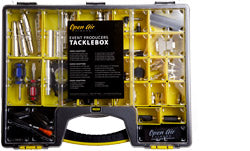 The following is an article published today in the LA Times which describes the growing trend of outdoor cinema. Outdoor movies are becoming more and more popular, and the demand for outdoor cinema products is growing rapidly. Open Air Cinema highly recommends this article as a resource on the current outdoor cinema industry for anyone who is interested in outdoor movies. Several outdoor movie companies nationwide are mentioned, as well as Open Air Cinema, one of the founders of the outdoor cinema products in the U.S. In this article you will find that outdoor movie events may not be the easiest endeavor, but it is definitely worth it.
The following is an article published today in the LA Times which describes the growing trend of outdoor cinema. Outdoor movies are becoming more and more popular, and the demand for outdoor cinema products is growing rapidly. Open Air Cinema highly recommends this article as a resource on the current outdoor cinema industry for anyone who is interested in outdoor movies. Several outdoor movie companies nationwide are mentioned, as well as Open Air Cinema, one of the founders of the outdoor cinema products in the U.S. In this article you will find that outdoor movie events may not be the easiest endeavor, but it is definitely worth it.
Screening Films Outdoors Is No Day In the Park- LA Times
by Tiffany Hsu
The lawn at the Grove shopping center looked like a slumber party one recent evening, as 75 people sprawled in sleeping bags and blankets on the grass to watch the 1984 film "Ghostbusters" on an inflatable screen. "It's nice to sit out and hang out, where there aren't as many restrictions as in a theater," said Jennifer Gerard, an advertising account executive. "It feels more like an event. Otherwise, I'd be sitting at home watching TV." That kind of four-star review is boosting a small but growing industry that provides outdoor movie screenings. Typically, they are hired by cities, community groups or other organizations that offer the show free of charge.
Last month's screening of "Ghostbusters" was staged by Open Air Productions, an Atwater Village company that has been in the business just under a year. It was hired by the Grove's management company, which puts on a variety of public events as part of its efforts to attract shoppers.
Open Air owner Dana Schwartz said she expected to screen 100 movies this year, at venues including a courthouse garden in Santa Barbara and an amphitheater at San Diego State University.
She has clients lined up through 2009 and employs a full-time event planner and 10 on-staff tech aides who perform such duties as audio-visual setup and customer service. Her company also helps secure the rights to screen films.
Schwartz estimates that the company will pull in just under $200,000 this year. That's "not bad" for a small open-air screening business, considering the expenses associated with constant equipment upgrades, she said.
"It's trying times for everyone, and there are other companies out there doing similar things, but everybody was pretty busy this summer," she said.
The number of outdoor screeners is difficult to track because no official association exists to do so, but most industry insiders agree that dozens of companies exist and that their numbers are growing.
Cities are among the most reliable customers. La Quinta's community services department sponsored a free summer series near City Hall featuring films such as "Ratatouille" and "Charlotte's Web" on a 20-foot screen. In July and August, audiences in San Jose saw films including "American Graffiti" and "The Shining" in San Pedro Square downtown.
Outdoor showings have recently been set up against such backdrops as the Brooklyn Bridge and the Sydney Opera House in Australia.
Demand for outdoor screens is snowballing, said Stuart Farmer, president of Open Air Cinema. The Lindon, Utah, company helps clients plan outdoor screenings and also sells inflatable screens, 80% of which go to large organizations or individual customers who want private backyard theaters.
But it pulls in at least $1 million a year from businesses that focus on outdoor films, Farmer said.
Boulder Outdoor Cinema in Boulder, Colo., launched with eight shows in 1995, when open-air screenings were more popular in Europe and in small towns with no theaters. This year, owner Dave Riepe and manager Jeanine Fritz screened nearly 20 films. The crowd quoted choice lines aloud during a screening of "The Big Lebowski" and viewers came in costume for "The Princess Bride."
"Watching a movie outside on a big screen in your little camping chair is just more fun," Fritz said. "It's more raucous. The sense of community is greater than if you roll into a multiplex and don't talk to your neighbors at all."
Schwartz of Open Air Productions had been an event planner for almost 10 years and had seen a growing demand to incorporate movies into outdoor events.
When Open Air Cinema approached her to head its California outdoor screenings, she jumped at the chance. The Utah company later decided to focus mostly on selling screens and other equipment, and this year Schwartz bought out its California screening operations and dubbed her company Open Air Productions.
The learning curve can be steep for newcomers, she said.
Successful business owners are usually film buffs with customer service acumen, she said. They must be able to handle power generators, cables, ambient lighting and a harrowing schedule that can involve as many as three shows a night.
Other issues include setting up portable restrooms, live-event insurance and arranging parking spaces for patrons. Fritz lines up city permits and checks for compliance with noise and environmental ordinances while drumming up sponsorships. She also books bands, plans concessions and organizes the roughly six employees who work at each event.
"You need a broad base of knowledge," Schwartz said. "I even watch my carbon footprint because I know someone will ask about it."
Revenue can be quickly sucked away, she said.
Partly because of high expenses, several groups well-known in the open-air cinema community say they operate as nonprofits, in the model of film festivals such as Sundance.
Mark Elijah Rosenberg, who founded Rooftop Films atop his New York apartment building in 1997 and is seeking nonprofit status, said another consideration was that venue, equipment, advertising, staffing and film-rights costs can and often do add up to more than ticket revenue. Many companies operate at a constant loss.
"Until you have a proven track record of getting big crowds, sponsors won't be involved," said Rosenberg, whose organization uses a chunk of its revenue to support independent filmmakers. "And unless you have a committed, long-term and stable plan, foundation and government support is unlikely. So it's not easy, under any model."
Even choosing films can be costly. After licensing costs soared this year, Fritz now estimates that each film costs her about $300 to show.
Some licensing and rental companies, such as Criterion Pictures USA in Morton Grove, Ill., vary rates depending on what title is being played and audience size, and also require clients to pay transportation and handling costs for the film.
Others collect a percentage of the box office but offer a flat rate for donation-based events. So some outdoor screening groups try to save money by requesting rather than requiring an entrance fee.
Tom Boss, director of Marin, Calif.-based Film Night in the Park, spends $1,500 to $3,000 producing each event. Lately, competition has siphoned away some of his audience, but 20 screenings spread over several Bay Area cities still drew more than 5,000 viewers, he said.
Still, organizing screenings is a "labor of love," said Boss, whose staff sometimes stays on-site nearly 12 hours, from setting up at 2 p.m. and ending when the equipment is dismantled.
The pressures can cause start-up outdoor film companies to fold quickly, he said.
"People think it's easy, and if you've just got a wall and are projecting for 20 people, it is," Boss said. "But when you're trying to do it for a big group, it's really labor-intensive and the equipment costs a lot. These companies get burnt out on the amount of effort it takes."
But Schwartz said production hiccups should fade as entrepreneurs get used to the demands of the business.
"These screenings aren't a fad like chocolate fountains were," Schwartz said. "It's in the vernacular now, and suddenly it's the hip thing to do."
Original LA Times Article: http://www.latimes.com/business/la-fi-screenings10-2008nov10,0,2162734.story?page=1
 The following is an article published today in the LA Times which describes the growing trend of outdoor cinema. Outdoor movies are becoming more and more popular, and the demand for outdoor cinema products is growing rapidly. Open Air Cinema highly recommends this article as a resource on the current outdoor cinema industry for anyone who is interested in outdoor movies. Several outdoor movie companies nationwide are mentioned, as well as Open Air Cinema, one of the founders of the outdoor cinema products in the U.S. In this article you will find that outdoor movie events may not be the easiest endeavor, but it is definitely worth it.
The following is an article published today in the LA Times which describes the growing trend of outdoor cinema. Outdoor movies are becoming more and more popular, and the demand for outdoor cinema products is growing rapidly. Open Air Cinema highly recommends this article as a resource on the current outdoor cinema industry for anyone who is interested in outdoor movies. Several outdoor movie companies nationwide are mentioned, as well as Open Air Cinema, one of the founders of the outdoor cinema products in the U.S. In this article you will find that outdoor movie events may not be the easiest endeavor, but it is definitely worth it.





